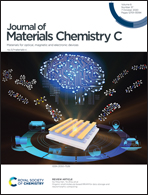Semiconductor-to-metal reconstructive phase transition and superconductivity of anti-perovskite Ca3PN under hydrostatic pressure†
Abstract
Anti-perovskite Ca3PN is investigated comprehensively under hydrostatic pressure by combining density functional theory (DFT) with crystal structure predictions. The post-post-perovskite phase is revealed to be part of the anti-perovskite “family” using a special reconstructive (with the same Pnma space groups) phase transition from the perovskite phase under pressure. Ca3PN further undergoes another two reconstructive phase transitions under higher pressure, where one is a semiconductor-to-metal transition and the other is a transformation between another two orthorhombic states – homogeneously with the same space group, i.e., Fmmm. Pressure-induced dynamical stability and mechanical properties of those stable phases are also predicted and explained. Most exciting of all, we even capture the superconducting critical temperature Tc (above 4 K), of the two metal phases in Ca3PN. These findings not only are an insight into an important and alluring process of reconstructive phase transitions in the anti-perovskite “family”, but also uncover unusual properties, thus stimulating experimental interest.



 Please wait while we load your content...
Please wait while we load your content...